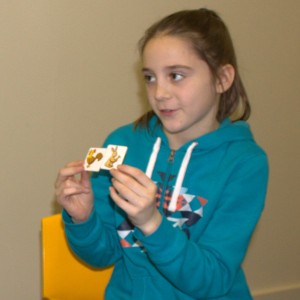 A well developed vocabulary is important for so many skills, including effective oral communication, well developed written language skills, fluent reading and reading comprehension. While school aged kids have developed most of the grammar skills used by adults, vocabulary continues to grow and develop right through school and beyond. Here are some games to help kids develop a bigger, better vocabulary.
A well developed vocabulary is important for so many skills, including effective oral communication, well developed written language skills, fluent reading and reading comprehension. While school aged kids have developed most of the grammar skills used by adults, vocabulary continues to grow and develop right through school and beyond. Here are some games to help kids develop a bigger, better vocabulary.
Brainstorming is a skill that helps develop use of more complex vocabulary and assists in problem solving skills such as thinking of a range of alternative responses to a situation. Brainstorming games are a fun, free way to develop kids vocabulary. You don’t need any equipment and you can play them anywhere. They are great for filling in time or while travelling in the car. They are also a useful way of preparing kids for new topics of learning and for preparing for written tasks such as story writing.
For a list of topics for using in your brainstorming games see our previous post.
Here are some brainstorming games:
1. Count the number of items you can think for each category in a specified time (one or two minutes) and try to beat the highest number.
2. Take turns to name an item within a category and the last person to think of an item is the winner.
3. Set a number e.g. ten items and use a timer to see who can think of that many items in the shortest amount of time.
4. Alphabet game. Choose a category and the first person thinks of an item beginning with A, the next with B and so on. E.g. Avocado, Brocoli, Carrot, etc
5. End to end. The first person’s word is written down and then the next person thinks of a word that starts with the last letter of that word e.g. Car, Railway, Yacht, Truck, Kayak
6. Acrostic. Write the name of the category vertically down the page and think of an item for each letter.
- Alligator
- Numbat
- Iguana
- Moose
- Anteater
- Lion
- Seal
7. Roll the dice. Write the names of different categories such as food, clothes, toys, body parts, transport, animals on some cards. Place the cards face down on the table. Choose a card and roll the dice. Can you think that number of items in the category you have chosen?
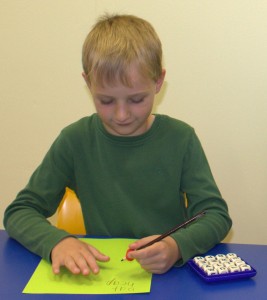 Children’s early language development includes learning to use and understand lots of individual words. As children develop a larger vocabulary they begin to understand that some words are often used together such as “shoes and socks”. They begin to understand that some words havesimilar meanings such as “big and huge” and others are opposites such as “big and little”. They also begin to learn categories such as: food, fruit, and clothes. Understanding how words relate to each other is important for learning in a range of subject areas in school and also helps children retain new knowledge by connecting new ideas with old and grouping related information together in memory.
Children’s early language development includes learning to use and understand lots of individual words. As children develop a larger vocabulary they begin to understand that some words are often used together such as “shoes and socks”. They begin to understand that some words havesimilar meanings such as “big and huge” and others are opposites such as “big and little”. They also begin to learn categories such as: food, fruit, and clothes. Understanding how words relate to each other is important for learning in a range of subject areas in school and also helps children retain new knowledge by connecting new ideas with old and grouping related information together in memory.
Words can be related by:
- Being used together e.g. shoe and sock
- Having the same function e.g. scissors and knife
- Being in the same category e.g. apple and banana
- Being opposites e.g. big and little
- Having similar meaning e.g. small and little
- Being part of a whole e.g. tree and branch
Here are some fun ways to help children develop word relationships:
To play some word relationship games make a collection of pictures of things that go together by either using photos from junk mail, clipart or by taking photos of things around the house. Word pairs might include: shoe and sock, toothbrush and toothpaste, dustpan and broom, knife and fork etc. Paste your pictures onto cardboard and cut into individual cards. Help your child learn the names of each picture and talk about how each item relates to it’s partner. For children who can read well you can simply write words onto cards. You can download suitable pictures from the “descriptive language and partners” game here. There also printable picture sheets on our pintrest page here.
8. What’s missing? Sort the cards into pairs and place each pair together on the table. Ask your child to cover their eyes while you turn one card from each pair face down. Can they look at the cards and guess which cards are turned over. Now put all the cards face up and mix them all together. Ask your child to close their eyes while you take away just one card. Can they match all the remaining cards and guess which one is missing?
9. Pairs fishing. Deal out five cards for each person and place the rest face down in a pile in the middle. Take turns to make pairs by asking for the pictures that go with the ones in your hand “I have a shoe, do you have a sock?” If you do not get a matching card take a card from the pile in the middle. The winner is the one with the most card pairs at the end.
10. Parts and wholes. Print or draw a large picture of an item such as a tree. Cut the picture into parts such as the trunk, branches, roots and leaves so that it is like a jigsaw puzzle. Practice naming the parts as you put the puzzle back together. Make a second puzzle of a different item such as a person. How are the parts of the person and the tree the same or different?
11. Word trees. Choose a describing word such as “big”. Write down all the words you can think of that mean big such as big, large, enormous, huge and so on branching out from the original word, see how many branches your tree can make. Check a thesaurus to see what words you missed and add them on.
12. Word ladders. Use the word list from the word tree game above. Now draw a ladder on a sheet of paper and arrange the words in order with the least big at the bottom and the biggest one at the top.
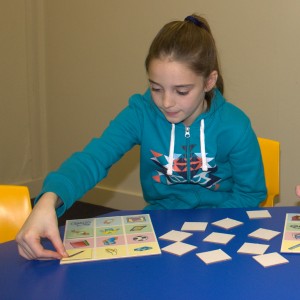 13. Memory match. Use your partners cards or any mixed set of picture cards to play memory by matching the pairs. Make the games more challenging players can match any pair of cards as long as they can explain why they go together.
13. Memory match. Use your partners cards or any mixed set of picture cards to play memory by matching the pairs. Make the games more challenging players can match any pair of cards as long as they can explain why they go together.
14. Similarity snap. Use the same cards as for the memory game but now try playing snap with them. Again you can match any pairs that you can explain are similar. Snap is more challenging as you have to think of a relationship between the two cards quickly before the other players do.
Using descriptive language is often difficult for children with language delays and disorders.Understanding descriptive language helps with comprehension of both spoken language and written information. Using descriptive language well helps with giving clear and specific instructions and with writing more interesting stories and more precise non fiction texts. Descriptive writing uses adjectives (which describe nouns) and adverbs (which describe verbs).
The acronym SCUMPS is useful for helping children use descriptive language. It stands for:
- Size
- Colour
- Use
- Material
- Parts
- Shape
Adjectives describe nouns (things and people) and can include: shape, colour, appearance, quality, sound, number, taste, texture, size and more. For a detailed list of adjectives click here.
Adverbs describe actions and can include: how, where, when, and why things are done. For a full list of adverbs click here.
Here are some ideas for developing descriptive oral language:
15. Feely bag. Place a number of objects in a bag. Ask your child to close their eyes and choose an object. Feel it while keeping the object inside the bag and describe it’s size, shape and texture. What might it be made of? What do they think it is used for? Are their different parts to it? Can someone guess what it is from the description?
16. Eye describe. Play this game in the car or around the house. Like eye spy choose something you can see and describe it and see who can guess what it is. Use the SCUMPS list as a help to give clues.
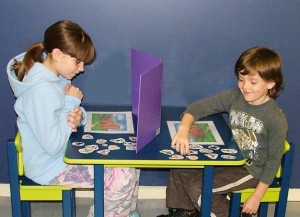
17. Descriptive barrier games. Use barrier games but make a rule that you cannot say the name of any of the objects, rather you need to describe them e.g. put the apple next to the banana might be “put the round red fruit next to the long yellow fruit”. For more information and some barrier games to download and print click here.
18. Character profiles. Cut some interesting photos of people from magazines or from clip art sites on the web. Give a description of your character including what they look like but also what you think their personality might be and what job or hobbies they might have. Choose three or four characters and make a story about them.
19. One guess who. Use cards for the traditional guess who game or use 10 or more pictures of people from magazines or clip art (if you do this you will need to name them). Spread your cards face up on the table. Choose a person and give a detailed description of them and see if your partner can guess who they are in one single guess. Try using pictures of places to play “one guess where” or pictures of objects to play “one guess what”.
Try these activities to develop descriptive language in written tasks:
20. Sentence builder. Write a simple sentence onto a piece of paper and cut up into individual words. Take turns to add a descriptive word or phrase to the sentence to make it longer and more interesting. e.g. “the boy ate apples, the little boy ate apples, the little boy ate four apples, the little boy ate four red apples, the little boy ate four red apples under the tree…” How long can you make your sentence?
21. Story change. Choose a passage from a book or magazine. If it is from a book make a copy. Use a highlighter to mark all the descriptive words. Change each descriptive word to something different. How does the story change? Can you use descriptive words to make the story scary or funny?
22. Story builder. Write about 10 to 12 descriptive words on cards and place them face down on the table. Use the links above for ideas and choose words suitable for your child’s language level. One person chooses a card and writes a sentence on a piece of paper to begin the story, but must include that word in the sentence. The next person chooses another word and writes a sentence to continue the story. How can you change your story by changing the descriptive words. Make lists of words to make certain types of stories such as scary or funny ones or ones about your child’s interests.
And finally some games to play in the car!
23. Scavenger describing. Make a list of describing words and give each person a copy. They might be something like: big, red, fast, heavy, tall etc. Kids can then write down an items they see that matches each of the describing words. The winner is the first to fill their list. If you laminate your list and use a whiteboard marker you can use your list over and over again.
24. 20 questions. One person thinks of an item and the other people have to ask yes/no questions to work out what the item is in less than 20 questions. Help kids to think about which questions are more useful (usually descriptive words or categories as they apply to a number of possible items) such as “Is it a living thing?” and which are less helpful such as “Is it a cat?”.
25. Advanced “I went to the shop and I bought…” Play the traditional game but try thinking of things that have a certain characteristic such as red things, big things or cold things ” I bought an apple, cherry, tomato…” Keep on adding until someone can’t think of anything more to add.
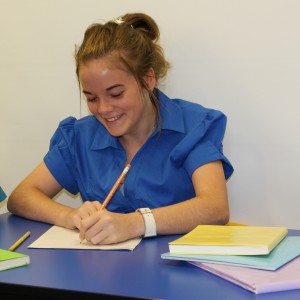 Have fun developing strong vocabulary skills! To find more fun activities for kids and lots of information about child development browse our website, Facebook page, Twitter, and Pinterest.
Have fun developing strong vocabulary skills! To find more fun activities for kids and lots of information about child development browse our website, Facebook page, Twitter, and Pinterest.
Looking for support for your child? If you have concerns about your child's speech or language skills the Talking Matters website has information about these skills. We provide individualised assessments and therapy for children with speech, language and learning difficulties and other disabilities. Our aim is to help parents help their child reach their potential. This information is not designed to replace professional support where this is needed rather it can be used in conjunction with professional therapy to support children's skill development.
To find out more about how the Talking Matters team can help your child click here. We provide speech pathology, occupational therapy and psychology services to children with a range of needs including language difficulties and autism spectrum disorders.
If you live in Adelaide and would like to discuss how Talking Matters can help your child call our friendly office staff on 08 (08) 8255 7137.
Jo Brenecki
Speech pathologist
Related Blog Posts
If you liked this post you may also like:
What is autism?
Weekend play dough
Using LEGO To Grow
Holiday fun!



